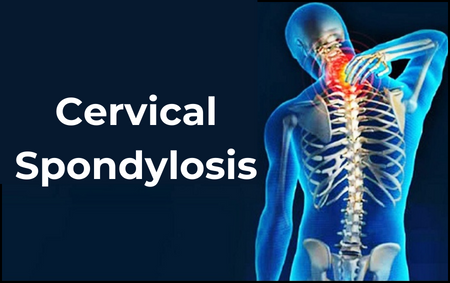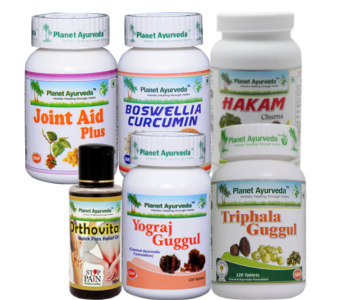NATURAL AYURVEDIC TREATMENT FOR CERVICAL SPONDYLOSIS
ABSTRACT
The problem of neck pain is very common in the general population. Cervical Spondylosis is a general and non-specific disease. Numerous types of neck issues are more common in the context of workers’ compensation. Even doctors can suffer from this condition since it appears that routinely performing operations that require abnormal neck positions predisposes the practitioner to the development of cervical pain. Most people who experience neck issues never go to the doctor. Those who do seek treatment typically have relatively modest problems that usually get well on their own or with no particular treatment. The difficulty for the primary care specialist is in early detection of the more severe diseases for early referral and in determining when to refer to those other patients who don’t respond to therapy. This article includes all the important points regarding the disease like its causes, symptoms, management and prevention in both modern and Ayurvedic aspects.

INTRODUCTION
The word “cervical spondylosis” refers to the degenerative alterations that either occur primarily as a result of ageing or secondarily as a result of trauma or another pathological condition. These adjustments happen gradually. According to most experts, the disc’s composition underwent a metabolic transition that resulted in less water content as the earliest event. Due to the disc’s lack of shock-absorbing function, this alters the biomechanics of the spine. The facet joints and ligaments, which make up the other parts of articulation between the vertebrae, undergo secondary modifications as a result.
CAUSES
- Disc that has lost moisture: According to science, discs serve as cushions between the spine’s vertebrae. The disc starts shrinking and drying out after 40 minutes. As the disks become smaller, there is more bone-on-bone contact between the vertebrae.
- Stiffness of ligaments: Spinal ligaments get stiff with age, which makes the neck less flexible.
- Spurs in bones: With the breakdown of the disc, the body may produce extra amounts of bone in a misguided manner.
- Herniated disc: The outer surfaces of the spinal disks also display signs of cracking. These minuscule openings can accommodate the disk’s soft interior. On occasion, it can cause the spinal cord and nerve roots to be crushed.
SYMPTOMS
- Neck discomfort and stiffness.
- The spinal canal within the spine’s bones has become more constrained.
- Tingling in the legs, feet, arms, or hands
- Weakness and numbness
- Having trouble walking
- Ineffective coordination
- Loss of bladder and bowel control
RISK FACTORS
- Neck injuries
- Smoking
- Age
- Occupation
- Genetic factors
MANAGEMENT
Physical examination:
- Looking at your neck’s range of motion
- To determine if there is pressure on your spinal nerves or spinal cord, test your reflexes and muscular strength.
- To determine if spinal compression is influencing your gait when you’re walking.
Imaging testings:
- Neck X-Ray
- MRI (Magnetic Resonance Imaging)
- CT scan
- Electromyography
- Nerve conduction study.
COMPLICATIONS
Severe cervical spondylosis may compress the spinal cord and nerve roots and also damage them permanently.
PREVENTIONS
- Stay physically active.
- Good posture
- Prevent neck injuries.
- Using the right forms of sports and exercises.
AYURVEDIC VIEW
Cervical Spondylosis is correlated with Greeva Stambh in Ayurveda. It is a disorder of Vata. Vyana vayu, a type of vata, is responsible for all the movements of the body. Charak Chikitsa 28/9
Nirukti (Etymology)
“Greeva Stambh” is a phrase used to describe neck discomfort and stiffness. Greeva stambh is a two-word phrase.
- Greeva
- Stambha
The nape of the neck, the back of the neck, and the tendon of the trapezius muscle all symbolise the word “Greeva.”
“Stambha” means Nischalikarana in Sanskrit. Stambha is a Sanskrit word that signifies immovability, rigidity, and stiffness.
NIDAN OF GREEVA STAMBH
Charak Chikitsa, 28/15-18
- Defence diet, small diet, short diet, excessive sex, excessive wakefulness
- Excessive bleeding, jumping, and swimming
- More walking, more exercise, and more labour
- To worry, to mourn, to sit on the sidelines, to get angry, to sleep during the day, to be afraid, to get hurt, etc.
- Heart attack, fasting, etc.
POORVA ROOPA/ PRE SYMPTOMS
Charak Chikita 28/19
There is no clear poorva roopa of greeva stambh in the literature of many acharyas.
SYMPTOMS OF GREEVA STAMBH
Charak Chikitsa 28/44
- Stiffness of the neck
- The patient starts grinding his teeth.
- Salivation from the mouth
- The back pulls backwards, there is stiffness in the head, frequent yawning, and the jaws become tight.
MANAGEMENT
- Snehan (oil massage with vata nashak dravya)
- Sweden (induced sweating)
- Upnah (especially to get relief from pain and swelling)
- Basti (medicated enema)
- Mridu virechan (mild purgations with vata nashak dravya)
- Nasya (medicated nasal drops)
HERBAL REMEDIES FOR GREEVA STAMBH BY PLANET AYURVEDA
Planet Ayurveda is a reputed and well-known herbal pharmaceutical company that manufactures pure herbal medicines. The company formulates pure plant-based herbal medicines. The company is well known for its plant extract-based preparations. The formulations are devoid of any adulterants or impurities. Planet Ayurveda provides some herbal remedies for Greeva Stambh. Here is the list of products:
- Joint Aid Plus
- Yograj Guggul
- Hakam churna
- Boswellia Curcumin
- Orthovita Oil
- Triphala Guggul


PRODUCT DESCRIPTION
1. Joint Aid Plus
These are the formulations of Planet Ayurveda with ingredients like Shallaki (Boswellia serrata), Ginger (Zingiber officinale), Nirgundi (Vitex negundo), Guggul (Commiphora mukul), and Ashwagandha (Withania somnifera). These capsules support and maintain healthy bones and joints. These capsules also include anti-inflammatory properties that help reduce swelling and inflammation in joints. It is also useful for acute and chronic arthritis.
Dosage: 1 capsule twice daily.
2. Yograj Guggul
This is a classical Ayurvedic preparation by Planet Ayurveda, having ingredients like guggul (Cammiphora mukul), chitrak (Plumbago zeylanica), jeerak (cumin seeds), and many others. It is very beneficial in the management of cervical spondylosis. It has the property of disc tissue regeneration. Yograj guggul also includes anti-inflammatory properties that are helpful in relieving pain.
Dosage: 2 tablets twice daily.
3. Boswellia Curcumin
This is an amazing preparation by Planet Ayurveda with ingredients like shallaki (Boswellia serrata) and curcumin (Curcuma longa). It has anti-inflammatory properties that are used for all types of joint pain. It is an herbal extract used to reduce inflammation. It also helps to reduce swelling and increase the body’s immune response.
Dosage: 2 capsules twice daily.
4. Hakam Churna
This is a preparation by Planet Ayurveda with ingredients like Chandrashoor (Lepidium sativum), Kalonji (Nigella sativa), and some others. Because of its anti-inflammatory qualities, it aids in the relief of chronic illnesses such as rheumatoid arthritis, sciatica, osteoarthritis, back stiffness, and cervical spondylitis. It also supports the immune system of the body and helps in digestion as it has warm properties. Dosage: 1 tsp twice daily.
5. Orthovita Oil
It is a preparation of Planet Ayurveda with ingredients like Gandhapura oil, Saindhavadi taila, Turpentine oil, Prasarini oil, Shul Gajendra oil, and camphor. It is recommended for joint pain. Saindhavadi oil is a classical oil for the management of joint and muscular pain. It helps in the mobility of joints, reduces inflammation, and strengthens muscles and tissues.
Dosage: Apply on the affected part.
6. Triphala Guggul
Triphala Guggul is a classical Ayurvedic formulation by Planet Ayurveda with ingredients like Bibhitaki (Terminalia billerica), Haritaki (Terminalia chebula), Amalaki (Emblica officinalis), and Shuddh Gandhak (Commiphora mukul). It has anti-inflammatory properties that help reduce pain and swelling. This also maintains the blood circulation in the body.
Dosage: 2 tablets twice daily.
CONCLUSION
Although Greeva Stambh is a very common disease found today due to a hectic lifestyle and change in dietary habits, it is characterized by the following symptoms: Greeva Shool (neck pain), Greeva Stambh (stiffness of the neck), Gatra Suptata (paresthesia), Greeva Hundana (restricted movement of the neck), Paniprastha Shiro Raja (radiation of pain to the back of the head, shoulder, and arms), Anidra (sle sleep disturbance), and Vertigo. However, positive outcomes can be achieved if the right treatment is provided at the right time with the logical use of both internal and external medicines. Planet Ayurveda provides the best medicines for the management of Greeva stambh.
Dr. Vikram Chauhan
Latest posts by Dr. Vikram Chauhan (see all)
- ALTERNATIVE AYURVEDIC TREATMENT FOR CHRONIC KIDNEY DISEASE - July 24, 2024
- Ayurvedic Treatment for Liver Disease with Herbal Remedies - July 22, 2024
- Ayurvedic Treatment For Diabetes Mellitus With Herbal Remedies - July 4, 2024
- Ayurvedic Aspect Of Liver And Management Of Liver Diseases - July 3, 2024
- Natural Ayurvedic Treatment For Fibromyalgia With Herbal Remedies - July 2, 2024




